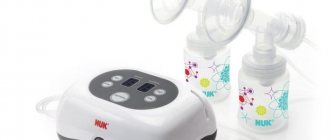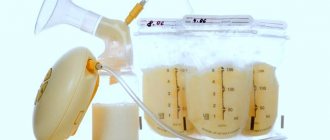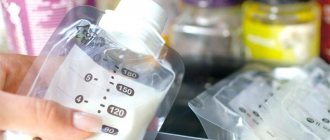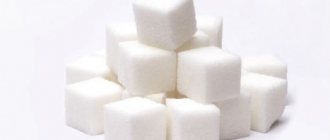The period of breastfeeding has its own characteristics that every mother should know about. One of the most common moments is pumping. The procedure is carried out manually or using special devices - breast pumps.
Expressing must be carried out correctly; incorrectly performed manipulations lead to disruption of lactation and cause the formation of stagnation. Therefore, most women prefer to use breast pumps. Today they are presented in a huge assortment, the main thing is to make the right choice. You will need to study information regarding the varieties. You can find out how to express breast milk with a breast pump from your doctor and read the instructions for the device.
When is it necessary to express with a breast pump?
Pumping is an optional process, but sometimes you simply cannot do without it.
- The birth of a premature baby. To feed the baby, the mother will need to express milk regularly. This is due to the fact that the baby is very weak, she has not yet developed a sucking reflex that allows her to eat on her own.
- Poorly developed sucking reflex, sometimes found in newborns. They often quickly get tired of sucking and fall asleep without satisfying their hunger. This will make them sleep restlessly and wake up quickly.
- Low lactation levels manifest themselves at different stages. The phenomenon occurs in the first months after birth or a year later.
- After birth, the baby may not eat fully, but the mother’s milk supply is quite active. To get rid of the discomfort of full breasts, you will need to express a small amount of milk.
- Pumping is mandatory for lactostasis, which threatens to develop into such a dangerous phenomenon as mastitis. Stagnation of this kind can be triggered by a wide variety of factors.
- Period of taking medications. The components of medications are transferred to the baby through milk. During treatment, to prevent lactation from decreasing, you will need to pump regularly.
- The structure of the breast, which is not convenient for sucking, often causes anxiety in the baby. If the nipple is too flat or inverted, you need to pump.
- If the mother is expected to be absent for some time, milk will need to be prepared for a couple of feedings, it is advisable to use a breast pump. With its help, you can prepare feedings for your baby faster and better.
Device types
The more primitive the equipment and the less well-known company that produces the product, the lower the price and quality, respectively. “The miser pays twice,” as we know, so here too there is a risk of making a mistake by choosing an unsuccessful specimen. The choice of this particular item is very individual for each woman; it is not a universal remedy. The main thing you need to understand is that a manual breast pump will require more time and labor than an electronic one, and the price of the first is less than the second. There are also services that rent out breast pumps - in this case, you can try out different types without unnecessary financial losses.
The leading manufacturers of breast pumps today are the Dutch company Avent and the Swiss company Medela. The first is a division of Philips and specializes in various products for newborns, while the second positions its activities in the field of breastfeeding and medical equipment. Both companies cite 30 years of experience, ongoing research and continuous improvement of their equipment.
What is good about these companies is a large assortment of both the product itself and spare parts, and various paraphernalia for it, high quality, widespread availability, and the availability of warranty service. The downside is that they are overpriced, which makes these breast pumps unavailable for purchase by ordinary people.
Video: presentation of the Medela brand
I really wanted this particular breast pump. Even at school for mothers I looked after him. You could even see how it works. This is the level, of course. Speedy milk collection, silent, two-phase pumping and very easy to wash and clean. For me, a working mother, this is what I need.
Lyudmila
https://rozetka.com.ua/medela_swing_030_0042/p2111412/
Video: presentation of the Avent brand
I’ve tried several breast pumps, some cheap and some not so good, and I’ve even used manual ones (but it takes a lot of time). Two competing brands really deserve attention: Medela Swing biphasic and Philips AVENT electronic. Unfortunately, I had to buy both. And not only them, to understand that you cannot save on a breast pump. I can immediately say that both work great and perform their function well, which cannot be said about cheaper models. Among the two, I single out Philips, because the manufacturer initially carefully thought out the process of easy assembly and disassembly of the breast pump, as well as ease of washing and sterilization. The manufacturer Medela has not finalized this function, it is very difficult to wash it, especially behind the valve (initially I did not attach any importance to this, and therefore my child acquired dysbacteriosis). This part with the valve cannot be sterilized (like bottles from this manufacturer), which is not a positive thing to use, because pathogenic microflora develops in the milk environment, which will have a bad effect primarily on the baby. I was in a hurry several times and tore off the valve - I had to buy new ones. After the third appearance of dysbiosis in my child (diagnosed by doctors), I decided to buy a Philips AVENT electronic breast pump. For more than 2 months now I have been saving time on washing and pumping with this miracle. Quickly disassembles, washes and puts back together. It's simple. And I’m not afraid that I’ll break something somewhere. By the way, Medela took 40 minutes of pumping, and AVENT 20 minutes, which is also important.
Catherine
https://rozetka.com.ua/philips_avent_scf332_01/p1203540/
A well-known Italian company that appears on the children's goods market and produces, among other things, breast pumps, Chicco is more affordable, but slightly lower in quality, and the product range is limited to basic models.
Video: Chicco manual breast pump
I bought this breast pump with caution, since there are very few reviews about it on the Internet. But I still hoped for the brand and took it. Before that I used Philips Avent (a breastfeeding consultant lent it to me), Chicco is no worse - about the same level. The only thing better than Avent is the softness of its operation - it does not cause any discomfort at all and does not put pressure on the chest. Quite easy to wash. The set includes a convenient stand, a lid for storing milk and a good anatomical nipple with a weak flow. The baby ate from it with pleasure.
Elena
https://rozetka.com.ua/chicco_natural_feeling_05740_00/p3646467/
After these giants, less famous companies Nuk, Canpol and many others are on the market - they are not so popular because they are not very convenient. Among the domestic ones, “World of Childhood”, which so far produces only mechanical versions.
expertcen.ru conducted research and determined the top 10 best breast pumps
Based on these characteristics and the needs/capabilities of your family, you can choose what is right for you and your child.
Types of breast pumps
Breast pump is a narrow-directional device. Using it, a woman can express milk without much difficulty. Devices produced today are easy to use. They save time and effort.
It is important to choose the right breast pump to prevent any possible breast injury. Today you can see many different options. Among such an abundance of models, every woman will choose the most suitable option for her use.
Pros and cons of different types of breast pumps
Today, customers have a wide variety of breast pump options to choose from. Among the most popular types it is worth highlighting:
- Pump-action;
- Piston;
- Syringe;
- Electronic;
- Electric.
We recommend reading: How breast milk is produced
Each model has positive and negative sides. To make the right choice, it is important to study the technical specifications. This is the only way to choose the most suitable model. Since the device is intended to be used for a long time.
Pump breast pump
The simplest version of a breast pump. The device belongs to the group of hand-held devices. The device consists of a rubber pump, a container where the milk will be collected. Some models are characterized by the absence of a milk container. When applying the device using a bulb and pressing it, a vacuum is created around the nipple. This is what causes milk to be expressed. The undeniable advantages of the model include low cost and absolutely silent operation. The disadvantages include the fact that fatigue quickly sets in during pumping. Women note that with frequent use, cracks begin to form on their nipples.
Manual breast pumps. How to express properly?
Setting intensity and speed:
To express with a breast pump, sit comfortably and relax. Place the breast pump so that the nipple is in the center of the funnel and moves freely, and begin active pumping.
Intensity regulation (vacuum):
The deeper you press the lever, the stronger the expression.
Speed regulation:
The faster you move the lever up and down, the faster the pumping speed.
We recommend starting pumping at a high speed and low intensity to stimulate the letdown reflex. Once milk begins to flow, you can reduce the speed and increase the intensity of pumping.
If you are going to buy a manual breast pump, pay your attention to the ARDO Amaryll manual breast pump; it combines such qualities as soft expression, comfort of use, individual approach and pumping efficiency.
— Lightweight and compact, the Amaryll manual breast pump is easy to assemble, use and clean. Ready to use immediately after unpacking.
— The ergonomic design of the handle ensures ease of use for both right-handers and left-handers. Stylish and laconic design ECO design.
— Minimizes pain due to the soft massage nozzle.
— Has an antibacterial barrier VacuuSeal and 100% protects breast milk from contact with the external environment and the proliferation of pathogenic bacteria, preventing contamination of the breast pump and milk.
— Made from the highest quality materials that do not contain BPA.
— Made in Switzerland.
Watch the video *
* The video is posted on the video hosting site www.youtube.com, the information is intended for persons over 18 years of age.
Piston breast pump
This type of device also belongs to hand-held devices. It consists of a special attachment for the breast, a container where milk is collected and a lever. Pressing the lever creates a vacuum around the nipple and causes the liquid to collect in the container. Expressing enough milk will require a lot of effort. You will have to hold the nozzle tightly against your chest with one hand and use the lever with the other. The advantages of the device include the following:
- The silicone nozzle allows you to create a comfortable sensation in contact with the breast, simulating the baby's sucking.
- The process, when performed correctly, takes a short amount of time.
- The operation is absolutely silent.
- Wide variety of models.
- Affordable price for a wide range of consumers.
- The collapsible design allows you to wash each part separately.
Despite the large number of advantages, it is worth mentioning the negative aspects. When buying a device, you should give preference to trusted manufacturers, otherwise the plastic parts will break down very quickly.
What to do if there is very little milk
If milk comes in insufficient quantities, you can make it come in using the following recommendations::
- Take a warm shower;
- Drink hot tea with added cow's milk;
- Place a terry towel soaked in water at 37 degrees on your chest;
- Relax, put your baby next to you and think only about good things.
- Carefully ensure that the baby receives the so-called “hind” milk, because I drank everything from my chest, without a trace. If this cannot be achieved, then in such cases you need to use a breast pump.
Thus, it is better to prepare 15 minutes before the expected feeding.
You can ask any questions on this topic to a lactation consultant; phone numbers for such services can be easily found on the Internet. Even if you have completely lost milk, there is still a chance to resume lactation.
Syringe breast pump
Consists of two cylindrical compartments. The inner part is attached to the nipple, the outer part moves back and forth. The device is inexpensive and is sold in many stores and pharmacies. It is very easy to keep it clean by regularly cleaning all parts. They are also distinguished by their small size and ease of use.
Electric breast pumps
Electrical devices are equipped with a special motor. It is his work that makes it possible to create a vacuum environment around the nipple. As a result, the milk begins to flow into a special bottle. The mother's job is to apply the nozzle to the breast, press the button, no more effort.
We recommend reading: Fat content of breast milk
Among the main advantages are:
- Useful memory function. Some models have a function that allows you to remember the most convenient operating mode.
- Ability to control the entire process. The procedure is carried out more intensively or, conversely, slowly. Such opportunities allow you to extract deeper milk from the breast.
- Very simple terms of use.
- Easy to care for. The device is very easy to disassemble and assemble for sterilization.
- The chest is not injured during work.
- Your hands don't get tired when pumping.
As for the shortcomings, there are practically none. The first point that raises doubts is the relatively high cost. Devices equipped with a motor are quite noisy. It is not possible to use the device near a sleeping baby.
How to choose the right breast pump
In order not to make a mistake with your choice, you need to consider several points. First, a woman must understand how long the device will be used or whether it will be needed for one-time use. The factor of how quickly the pumping process should occur is also taken into account.
For infrequent use, hand-held devices, which are affordable, are suitable. If pumping will be carried out regularly, then it is preferable to choose electric models with a motor. They will allow the mother to complete the procedure faster and empty the breast completely. All expensive models must have a certificate of conformity. It is important to check all the documents in order to buy only high-quality products that will last a long time.
Manually or with a breast pump
Have you used a breast pump?
Not really
Today, store shelves are overflowing with various devices for maintaining lactation.
To stimulate milk production, you can purchase a breast pump. It comes in manual and electric control.
Each mother chooses for herself what is convenient for her or is guided by price.
This device is not suitable for use in the following cases::
- Immediately after childbirth, since the breasts must first be developed manually;
- For hard and swollen breasts with excess milk;
Gynecologists usually consider these cases to be indications for using a breast pump.
Perhaps the most popular is Philips Avent, it is manual, which means the whole process will not happen quickly. There are also a lot of good reviews on the Medela electric breast pump.
When choosing this device, it is necessary to choose the right nipple shield, otherwise the feeding process will cause pain to the mother and will not be effective.
The classic way to obtain milk without the baby's help is by manually kneading the breast. This method was used by previous generations. However, it can cause pain and discomfort. Getting milk using it takes a long time and is unpleasant.
With a breast pump you can collect the required amount of milk quickly and with less effort.
Each method has its own advantages and disadvantages. In this regard, it is better to use them simultaneously depending on the current situation.
Breastfeeding can provide wonderful moments for mom and baby that will be remembered for years to come. This natural process can be easy and comfortable for both. The main thing is to adhere to these rules, and then the baby will give you happy hours of peace of mind.
Correct pumping technique
It is important to learn how to properly express breast milk with a breast pump. A breast pump is a very practical device that will make a mother's life easier. For the procedure to go well, you need to perform a number of actions, special attention is paid to preparation.
- Before using the device for the first time, you will need to study the instructions and sterilize all removable parts of the device.
- When purchasing, you should pay special attention to the funnel. Its shape should perfectly suit the shape of the breast. The funnel should completely follow the shape of the nipple. Otherwise, the whole procedure will cause discomfort and fighting sensations.
- After the baby is born, additional nipple shaping procedures may be required. This will not only help you successfully use the breast pump, but it will also make breastfeeding much more comfortable for your baby in the future. There are many cases where pumping is an additional method to develop breasts.
- To pump, you need to choose the most convenient place and comfortable position.
- Before performing the procedure, be sure to wash your hands.
- Before using the device, you will need to stimulate your breasts. This can be done by giving a light massage or taking a warm shower. Such manipulations will stimulate the flow of milk.
- The speed of expressing breast milk with a breast pump is selected individually, the main thing is that it is comfortable.
Basic rules for expressing breast milk
If you follow these rules, pumping procedures will be completely safe and will only bring benefits:
- Pumping your breasts shouldn't hurt! If any painful sensations appear, this indicates an incorrect technique, and pumping must be stopped.
- Before the procedure, be sure to wash your hands with soap and prepare a clean, boiled container for the resulting dairy product.
- In order for pumping to go as quickly and painlessly as possible, you need to induce a flow of milk before it (wash your breasts with warm water, contact the baby, drink a warm drink, lightly massage the mammary glands, give one breast to the baby and express the other at the same time).
- After the milk has arrived, you need to express it by hand or use a special machine. When manually expressing, only the correct technique is important (you can learn more about how to express breast milk by hand in this article). When undergoing a hardware procedure, you should choose the right breast pump and accessories (read more about pumping here).
Massage the mammary glands carefully and gently, in a circular motion, without squeezing them.
Manual expression technique
It is necessary to alternately change the grip of the areola to horizontal and vertical. This type of pumping will be more effective.
The correct position of the fingers when grasping the nipple is indicated by green arrows. Red arrows indicate incorrect grip
Selecting a breast pump funnel according to nipple size
- The pumping process should not be too fast. Do not pull, press or tug on your chest too much. You need to work for 4-5 minutes with each mammary gland alternately.
- If you don’t manage to express the first time, then don’t despair. You need to try again, and soon everything will definitely work out. The main thing is not to be too zealous so as not to damage your breasts.
How often should you express milk during breastfeeding?
The frequency of pumping depends on individual characteristics. There are a number of recommendations that are worth considering.
- If after giving birth it is not possible to feed the baby, but there is a desire to maintain full lactation, the first pumping will need to be done 5-6 hours after the birth of the baby. Afterwards the procedure should be carried out every three hours.
- When the breastfeeding regimen is established, but you need to leave for a certain time, pumping is carried out according to the schedule.
- When the baby does not eat all of her mother’s milk and after finishing feeding she feels heaviness, using the device you will need to empty her to a comfortable feeling of relief.
We recommend reading: Milk stagnation during breastfeeding
When and how often?
If there is a need to express a certain amount of milk, then this procedure must be carried out at the same time.
This is necessary to develop a lactation regime and prevent congestion .
You can empty your breasts of milk before and after feeding. Before the baby asks to eat, you can drain a few drops.
If a child is often lazy to suck milk, then this stage of feeding will be carried out regularly. It improves milk flow and makes it more accessible to the baby.
After the baby is full, after 40 minutes you can try again to empty the breast of a few milliliters of milk.
If the mother has an excess of it, and for the baby this amount is unbearable, then in this way the woman will be able to alleviate her condition.
To maintain lactation, it is necessary to feed at night, from about 2:00 to 6:00 . It is this that promotes the flow of milk in sufficient quantities during the daytime.
If milk production is insufficient, and if the baby does not wake up at night, it is recommended to receive milk without the help of the baby.
This will prevent premature and unwanted cessation of lactation.
The period of artificial stimulation of lactation cannot exceed 10 - 15 minutes . This will be enough to collect milk for one feeding.
If a mother wants to free the thoracic ducts for her own relief from excess milk production, this process should not be delayed for more than 5 minutes.
To be sure that your baby is getting enough, you need to know how much milk a newborn should eat.
You will find other useful materials in the “Breastfeeding” section.
How long can you store expressed milk during breastfeeding?
Many women are concerned about how long breast milk can be stored. Breast milk has unique antibacterial and anti-infective properties, which allows it to be stored for a long time. By following the basic recommendations for storing expressed breast milk, it can stand at room temperature for up to 8 hours, and up to a week when stored in the refrigerator.
If there is a need for longer storage, milk can be frozen in the freezer. When feeding expressed milk safely, it is important to follow basic storage and use guidelines. High-quality containers must be used for storage. Bottles must be made only from high quality materials.
For freezing, special packages can be selected that are convenient to store and later use the product. Frozen milk must be defrosted correctly without using direct heat treatment. From the freezer, you need to place it in the refrigerator until completely upset.
The correct choice of device and its use will greatly facilitate the life of a mother during breastfeeding. It’s better not to make a hasty choice; it’s worth exploring a variety of options.
Is it possible to mix milk expressed at different times?
Often the mother leaves the milk that the baby hasn’t drunk in a bottle and puts it in the refrigerator.
At the next feeding, the baby may not finish it again. In this case, it is possible to mix milk from different feedings in one container, but it is not recommended to do this regularly.
You can only put milk at the same temperature in one bottle.
With each new feeding, the milk may have a different consistency and taste . When mixing portions received in the morning or evening, and maybe on another day, an unpredictable result is possible. It can result in changes in the taste, smell, and consistency of milk, which can adversely affect the baby’s appetite and health.
In addition, it is important to observe shelf life, and when mixing different portions, some of the milk will be less fresh. This should not be allowed. You can read more about shelf life in the material at our link.











